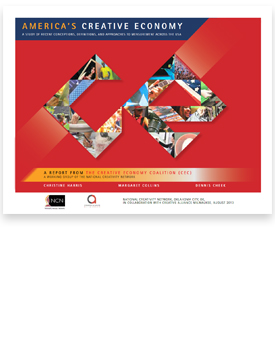The Creative Economy Coalition or CEC, a Working Group of the National Creativity Network, decided to inaugurate a project that directly led to the creation of this report. As organizations charged with responsibility for serving the creative economy in their respective regions came together starting in 2010 to discuss common issues, challenges and opportunities, they increasingly found
it difficult to share a common language around both definition and measurement.
This research project was designed to profile and analyze how the creative economy is currently being defined, segmented and quantified throughout the United States of America. We assessed what we can learn from aggregating creative economy profiles, and whether there is the possibility of producing a ‘core’ national profile definition and accompanying data descriptors.The following research questions were posed:
- How are ‘creative economy/industries’ currently being defined around the United States by those entities that have articulated a mission to serve the creative industries? The words creative economy/industries are used together because this nomenclature is used interchangeably across the country. This report gives an overview of the written definitions being used for the creative economy as well as the actual descriptors and datasets used to measure them.
- What position and value do nonprofit arts organizations have in this profiling, and how are they being impacted by the creative economy? Whether organizations which have produced a creative economy profile did or did not address the nonprofit arts sector directly was unknown until the information was collected and collated. Therefore, it was unclear whether or not this question could be answered from this research. [Exective Summary]
This research project was designed to profile and analyze how the creative economy is currently being defined, segmented and quantified throughout the United States of America. We assessed what we can learn from aggregating creative economy profiles, and whether there is the possibility of producing a ‘core’ national profile definition and accompanying data descriptors [Executive Summmary]


Most Commented